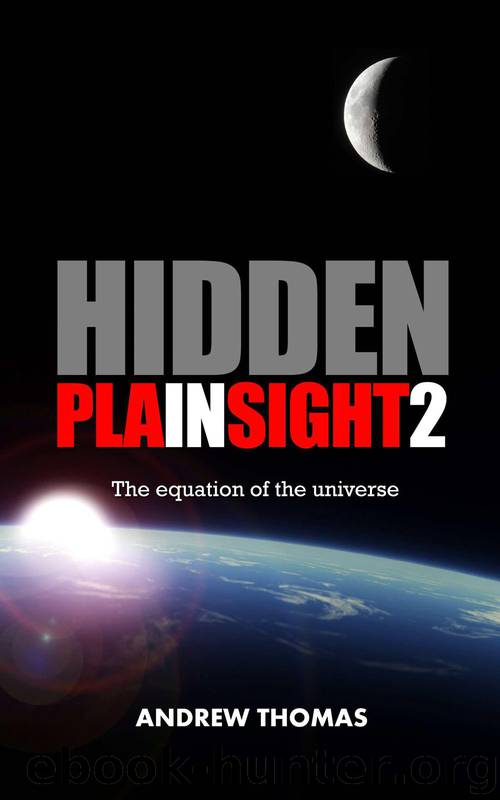Hidden In Plain Sight 2: The equation of the universe by Thomas Andrew

Author:Thomas, Andrew [Thomas, Andrew]
Language: eng
Format: epub
Published: 2013-06-15T04:00:00+00:00
The biggest error in science
The required value for the vacuum energy is extraordinarily small — in the order of a millionth of a billionth of a joule per cubic centimetre. The effect has a cumulative effect over distance, so it must be extremely small or else the universe would be ripped apart over large distances. Even at the vast scales of the Milky Way, the effect is unnoticeable. The repulsive effect only becomes noticeable at the scale of the whole universe.
So we need an astonishingly small value for the vacuum energy. However, when attempts are made to calculate the amount of vacuum energy, the result is very different to that required to be the dark energy. In fact, the value for the vacuum energy is calculated to be an enormous figure: a trillion trillion trillion trillion trillion trillion trillion trillion trillion trillion trillion trillion times larger than the observed value of dark energy density. And that's a lot of trillions! Famously, this has been called the "biggest error in the history of science". Vacuum energy is predicted to be far too large to be dark energy.
This sounds suspicious. The sums for this vacuum energy hypothesis simply do not add up. Not only do they not add up, they are astronomically wrong. It is possible that there is some mechanism which greatly reduces the vacuum energy, for example, the energy of different types of symmetrical particles might cancel each other out. But we would generally expect this cancelling mechanism to result in a zero vacuum energy, not a tiny value.
However, the problem with the necessary value of the vacuum energy is not that it is so much smaller than the predicted value. The problem is that it is set to a particular tiny value which results in an "interesting" universe. If the universe expanded at too fast a rate, galaxies would be unable to form. If the universe expanded too slowly, it would collapse back on itself before intelligent life could form. The amount of vacuum energy required is not just set to a much lower value than predicted, it is set to just the right much lower value than predicted. This gives an impression of fine-tuning of the vacuum energy.
There are more bizarre coincidences. The predicted density of dark energy in the universe is remarkably close to the density of matter in the universe. This is surprising as the density of matter reduces sharply as the size of the universe increases (the matter becomes more diffuse), whereas the dark energy density remains constant. The dark energy density remains constant purely because it is the energy of empty space: as the size of the universe increases, so does the amount of empty space. This apparent balance between the amount of mass and the amount of dark energy has been called the cosmic coincidence problem. This coincidence — this unlikely balance — appears to indicate that there is something very special about the current era.
In order to explain these apparent fine-tuning problems, the dreaded "multiverse" model has been introduced.
Download
This site does not store any files on its server. We only index and link to content provided by other sites. Please contact the content providers to delete copyright contents if any and email us, we'll remove relevant links or contents immediately.
The Complete Stick Figure Physics Tutorials by Allen Sarah(6638)
Secrets of Antigravity Propulsion: Tesla, UFOs, and Classified Aerospace Technology by Ph.D. Paul A. Laviolette(3448)
Thing Explainer by Randall Munroe(3327)
The River of Consciousness by Oliver Sacks(2992)
The Order of Time by Carlo Rovelli(2714)
I Live in the Future & Here's How It Works by Nick Bilton(2524)
How To by Randall Munroe(2474)
A Brief History of Time by Stephen Hawking(2473)
The Great Unknown by Marcus du Sautoy(2186)
What If?: Serious Scientific Answers to Absurd Hypothetical Questions by Randall Munroe(2170)
Blockchain: Ultimate Step By Step Guide To Understanding Blockchain Technology, Bitcoin Creation, and the future of Money (Novice to Expert) by Keizer Söze(2137)
Midnight in Chernobyl by Adam Higginbotham(2078)
Networks: An Introduction by Newman Mark(1998)
The Meaning of it All by Richard Feynman(1909)
Easy Electronics by Charles Platt(1864)
The Tao of Physics by Fritjof Capra(1848)
When by Daniel H Pink(1777)
Midnight in Chernobyl: The Untold Story of the World's Greatest Nuclear Disaster by Adam Higginbotham(1775)
Introducing Relativity by Bruce Bassett(1754)
